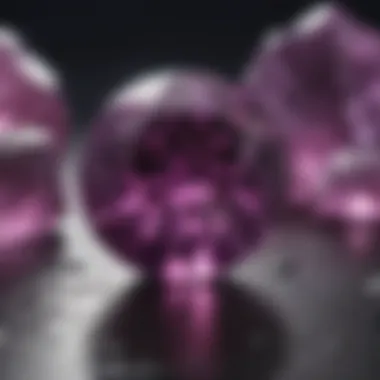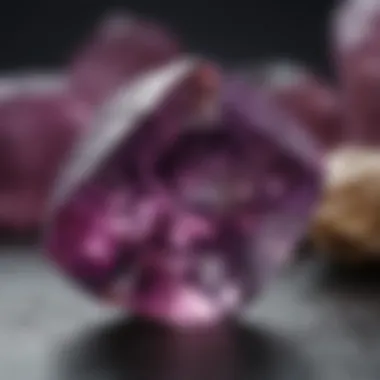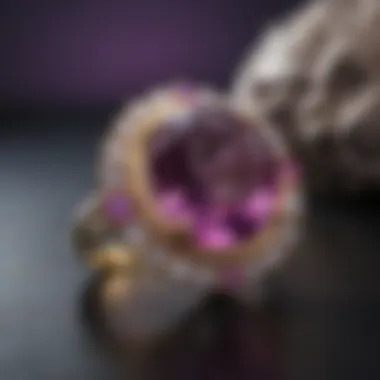The Allure of Purple Topaz: A Comprehensive Guide


Intro
Purple topaz, a gemstone that catches the eye in any setting, has an allure that draws in collectors and enthusiasts. There’s something remarkably captivating about its rich hues, which seem to range from soft lavender to deeper, vibrant shades. Beyond just aesthetics, the geological properties and historical narratives encased within this striking mineral add a fascinating depth to understanding its value.
As we peel back the layers, we unearth the rich history and origins of purple topaz, explore its characteristics, delve into the identification process, and discover the practical measures every collector ought to know. This exploration isn't merely about gathering facts; it's a journey through time and culture, where each facet of purple topaz tells its own story.
History and Origins
Overview of Collectibles, Rocks, and Fossils
The realm of collectibles encompasses a wide variety of items; however, gemstones have always held a special place. Among them, purple topaz stands out, not just for its own unique charm but also for its historical journey, which ties in with the broader context of minerals and fossils.
Purple topaz, a variant of topaz, has been cherished since ancient times. Its earliest mentions often tie back to civilizations that prized various gemstones for their perceived properties—some believed in their healing attributes, while others saw them as symbols of wealth. In many ways, purple topaz encapsulates the rich narrative of collecting, where every stone tells a story.
Historical Significance and Cultural Impact
Over centuries, purple topaz has graced royal crowns and treasured jewelry boxes alike. In ancient Egypt, it was believed to embody divine energy, and some even associated it with the sun god, Ra. Similarly, Greek mythology whispers of the connections between topaz and tranquility.
The 19th century brought about the principle of discovering more minerals and their potential uses. During this period, the unique appeal of purple topaz began to shine in the world of collectibles, garnering attention from jewelers and gem traders. Its stunning appearance and relative rarity made it a sought-after piece for both ornamentation and investment.
"Purple topaz isn’t just another rock to be collected; it’s a narrative—a blend of geology and history, waiting to be discovered."
Today, purple topaz continues to engender interest from collectors who seek to possess not just the stone itself but the stories etched within its crystalline form. Understanding its origins adds a layer of appreciation that elevates it beyond a mere decorative element.
Identification and Classification
Guide to Identifying Rocks and Fossils
Proper identification of purple topaz involves keen observation. It is essential to know its primary attributes: often, the gem displays a glassy sheen, a transparency that allows light to pass beautifully through it. The color variations can span a spectrum, but the telltale purple hue is unmistakably its hallmark.
To distinguish purple topaz from other gemstones, collectors should be aware of the following:
- Color variations: Ranging from lavender to deep purple.
- Cleavage: Purple topaz exhibits perfect cleavage in one direction. This is profound for those who are familiar with gemstone structures.
- Hardness: It scores an 8 on the Mohs scale, making it quite durable yet still more fragile than diamonds.
Common Types and Variations
Within the umbrella of purple topaz, subtle variations exist, influenced by trace elements and their environments. Here are some notable types:
- Imperial Topaz: Often mistakenly referred to, but the true imperial offers a golden hue, not purple.
- Lavender Topaz: This lighter shade adds a soft touch, appealing to another segment of collectors.
Such variations lead to a unique classification of purple topaz pieces for collectors, nurturing a deeper appreciation for each type's rarity and beauty.
In summary, purple topaz, with its historical significance and captivating appearance, offers a vast world for both old and new collectors to discover. By understanding its origins, identification methods, and types, enthusiasts can not only enhance their collections but also the stories they tell.
Understanding Purple Topaz
Purple topaz holds a captivating position in the realm of gemstones, drawing interest not just for its beauty but also for its unique qualities. This section aims to lay the groundwork for understanding the significance of purple topaz. Within various styles and settings, this gemstone is widely appreciated for its rich hue and clarity.
The allure of purple topaz goes beyond mere aesthetics; perhaps the most notable aspect is the geological history that has shaped its existence. Knowing where it comes from enriches the collector's appreciation, turning what may seem like just another stone into a chapter in Earth’s narrative.
What is Purple Topaz?
Purple topaz is a variety of topaz that features shades ranging from lavender to deep purple. This gemstone is composed primarily of aluminum silicate fluoride hydroxide. What sets purple topaz apart from other types of topaz is the presence of trace elements, which contribute to its distinct color. Traditionally regarded as a symbol of love and affection, purple topaz is often used in jewelry, decorative objects, and various forms of art.
Geological Formation
The geological formation of purple topaz involves a complex set of processes that showcases nature's creativity.
Mineral Composition
The mineral composition of purple topaz is a fundamental aspect of its allure. Comprising mainly of aluminum silicate, this mineral packs a punch in terms of durability. The presence of trace elements, primarily chromium and iron, induces the deep purple hue. While amethyst gets its color from the same elements, what sets purple topaz apart is its remarkable transparency and brilliance, which many collectors find appealing. This clarity allows light to pass through, creating a vibrant interplay of colors. However, its hardness, rated at eight on the Mohs scale, makes it a practical choice in jewelry, ensuring it withstands the test of time.
Formation Process


The formation process of purple topaz is equally intriguing. Formed under conditions that involve high temperature and pressure, purple topaz crystals usually develop in igneous rocks, particularly granite. Their growth depends on the right mix of geological factors like pH levels and temperature, which creates a favorable environment for this mineral to flourish. This makes purple topaz a unique story of natural beauty, showcasing the role of evolving earth conditions over millions of years. Collectors often seek gemstones that display a multifaceted story behind their formation, making this an appealing aspect of purple topaz.
Geographic Locations
Geographical locations play a crucial role in the quality and characteristics of purple topaz. The foremost known source of quality purple topaz is Brazil, which yields some of the most vibrant specimens available on the market. In addition, locations in Russia and Mexico are noted for their own unique varieties. Each region contributes specific characteristics influenced by local geology and mineral conditions. This geographical diversity means that purple topaz can vary significantly in shade and appearance, offering collectors a wide selection depending on their preference.
"Understanding the origins and geological qualities of purple topaz transforms it from mere decoration into a treasure with history and story."
By exploring these facets of purple topaz, one can appreciate its overall significance in mineralogy and the world of collectibles.
Chemical Properties
Understanding the chemical properties of purple topaz plays a pivotal role in appreciating its allure and distinguishing it from other gemstones. At its core, purple topaz is primarily composed of aluminum silicate fluoride hydroxide, and its unique physical traits stem directly from this composition. The presence of trace elements such as iron and manganese can influence not just the color but also the crystal clarity and durability of the stone. These properties not only impact the aesthetic allure of the gemstone but they also determine its practical applications, particularly in jewelry design.
Crystal Structure
The structure of purple topaz is categorized under the orthorhombic crystal system, which means it has unique axis lengths and angles that define its shape. Crystals of this nature commonly form in cavities within volcanic rocks, resulting in various growth patterns. The form that purple topaz takes can vary significantly — some crystals appear as elongated prismatic shapes, while others may be more tabular.
Crystallography plays a significant role in how light interacts with purple topaz, resulting in its sought-after brilliance and clarity. A well-formed topaz crystal will exhibit a vitreous luster, giving it a glass-like appearance that magnifies its beauty, enticing collectors and enthusiasts alike.
Color Variations
The color of purple topaz is one of its standout features, and it varies due to several influencing factors.
Factors Influencing Color
A fundamental contributor to the color of purple topaz is the presence of trace elements during the formation process, primarily iron, and manganese. These elements absorb certain wavelengths of light, leading to the wide spectrum of purple hues that can range from lavender to deeper violet tones. Additionally, the temperature and pressure conditions during the formation also impact the gemstone’s coloration, making it quite the fascinating specimen for any collector.
When considering the watercolor, it's crucial to note that deeper shades of purple are often more desirable and fetch higher prices in the market due to their rarity.
Comparison to Other Gemstones
In the realm of gemstones, the color variations of purple topaz invite comparison with other stones like amethyst and lavender sapphire. Each of these stones, while potentially sharing a similar hue, offers distinct characteristics. Amethyst, for example, is renowned for its vibrant purples but tends to exhibit tints of red or blue under different lighting conditions.
In contrast, purple topaz boasts greater clarity and brilliance due to its crystal structure. Where amethyst can often appear more opaque, purple topaz can shine vividly due to its transparency. This unique clarity is one reason why collectors often favor purple topaz over other purple gemstones.
"The interplay of color and light within each stone offers collectors not just beauty, but also a story woven from the very elements of the earth."
Collecting purple topaz not only provides individuals with an opportunity to own a unique piece of nature's artistry but also allows them to appreciate the intricate chemistry involved in creating such distinctive colors.
Historical Context
The significance of historical context cannot be overstated when delving into something as complex and captivating as purple topaz. This gemstone is not merely a visual marvel; it embodies centuries of cultural and practical relevance that reflects human relationships with nature and material adornments. By exploring the ancient uses and cultural implications of purple topaz, we gain deeper insights into why this gemstone continues to be sought after and revered. Its journey through time reveals not just its physical allure, but also its intertwining with human emotion and expression.
Ancient Uses of Topaz
For millennia, purple topaz has held a place of honor in various civilizations, respected not only for its beauty but also for its supposed mystical properties. The ancient Egyptians, for instance, believed that topaz was infused with the power of the sun, safeguarding its wearers and providing them strength and protection. Its vibrant hues also made it a popular choice for royal adornments. Treasure from tombs includes purple topaz pieces, suggesting that these gemstones were not simply decorative—they were thought to carry spiritual significance as well.
The Sumerians also recognized the value of purple topaz, using it in amulets that were meant to ward off evil spirits. These historical applications highlight the gemstone's enduring significance as a symbol of protection and power. The properties attributed to purple topaz in antiquity reinforce its use in cultural rituals and personal adornments, pointing to a belief in the stone’s ability to influence well-being.
Cultural Significance
Symbolism in Different Cultures
Throughout history, purple topaz has transcended its identity as a mere gemstone, becoming a symbol within various cultures. In many traditions, its rich purple tones are associated with royalty, luxury, and wisdom. This color, often linked to nobility, is a testament to the stone's perceived power and elegance. For instance, some cultures view purple as the color of the crown, which reflects authority and connection to the divine, making purple topaz a preferred choice among the elite.
Furthermore, this gemstone holds a place in spiritual practices. Traditionally, it has been seen as a stone that could enhance one’s creativity and help with communication. Its presence in personal artifacts suggests that it had the power to evoke calmness and focus in its bearer, which can be appealing to modern collectors seeking not just beauty in their collection but also the energies aligned with these historical beliefs.
Historical Figures and Their Affinities
Several figures throughout history have shown a penchant for purple topaz, associating themselves with its splendor and purported properties. For instance, notable royals often adorned themselves with purple gemstones as symbols of their status. The famous Empress Josephine, wife of Napoleon Bonaparte, is rumored to have cherished purple topaz for its beauty and the air of sophistication it imparted. Such historical affiliations elevate the gemstone's status, influencing collectors who wish to own a piece of history tied to these iconic names.
The allure of purple topaz as worn by historical figures generally emphasizes its value as a collector's item. Owning a purple topaz piece not only enriches a collection aesthetically but also allows individuals to connect to the legacies of those whom history deemed worthy. This connection can inspire a personal affinity for the gemstone, prompting collectors to seek out authentic pieces that echo these rich stories and narratives.
Modern Applications


The relevance of modern applications of purple topaz extends beyond its status as a mere decorative gem. In the contemporary landscape, this gemstone has carved a niche both in the realm of jewelry and various industrial sectors. Understanding these applications is crucial for collectors, enthusiasts, and anyone intrigued by the multifaceted use of minerals.
Jewelry Design
Popular Styles and Settings
When it comes to purple topaz, the popularity of different styles and settings showcases the gemstone's versatile beauty. Most jewelry designers opt for classic styles that allow the gem’s natural charm to shine through. Settings like prong and halo are particularly favored as they elevate the color and brilliance of the stone.
Additionally, intricate designs, such as vintage-inspired settings, resonate well with collectors looking for unique pieces. What's fascinating about these styles is how they highlight the vividness of purple topaz. A well-crafted ring or pendant can bring out the gemstone's deep hues and subtle variations, making it a treasured accessory.
However, crafting these high-level designs is not without challenges. Certain styles may require more meticulous craftsmanship, potentially leading to higher costs. Yet, the aesthetic reward often outweighs these considerations for buyers seeking exceptional jewelry.
Craftsmanship and Artistry
Craftsmanship plays a pivotal role in enhancing the allure of purple topaz jewelry. The skill and precision involved in shaping and setting the gem can define the final aesthetics of the piece. One of the key characteristics of fine craftsmanship is its attention to detail, which ensures the gem is securely placed without compromising its sparkle.
Moreover, contemporary jewelers are experimenting with innovative techniques, such as stone inlaying and mixed media settings, adding a modern twist to traditional methods. While this makes jewelry more visually appealing, it sometimes involves a trade-off regarding durability, particularly when using softer materials alongside topaz.
Industrial Uses
Applications in Technology
Beyond the glimmering jewelry, purple topaz has made its presence felt in tech industries. An area of growing significance is its use in laser technology. Due to its specific optical properties, purple topaz is utilized in crafting certain types of laser components that are crucial for precision in manufacturing and medical applications.
This application is noteworthy because it represents a shift where gemstones supply critical functionality beyond decorative purposes. However, the demand for laser-grade material can lead to a scarcity in the market, affecting jewelry production. Therefore, this dual-use aspect presents a unique consideration for potential collectors interested in both aesthetic and practical value in the same gemstone.
Research and Development
In the realm of research and development, the qualities of purple topaz are being explored in mineralogical studies and gemology. Scientists examine its crystal structure and formation processes to gain insights that can influence how other gemstones are categorized and consequently valued.
The exploration of new applications, especially in enhancing our understanding of earth materials, is a compelling focus in gemology research. Such studies not only amplify the appreciation for purple topaz but can also serve as a reminder of its broader significance within geological contexts. However, as research methodologies evolve, so does the potential for misinterpretation of findings, which raises the stakes for clarity and accuracy in this field.
The modern applications of purple topaz exemplify how a gemstone can bridge the gap between beauty and utility, captivating not just jewelry lovers, but also industries aiming for innovative advancements. As more collectors recognize these multifaceted uses, the appeal of purple topaz will likely continue to grow.
Collecting Purple Topaz
Collecting purple topaz offers a unique blend of beauty and rarity, making it a fascinating pursuit for both novices and seasoned enthusiasts alike. As this gemstone continues to gain traction in the world of collectibles, understanding how to identify, value, and care for purple topaz becomes essential. The objective of this section is to provide collectors with the necessary knowledge to navigate this intricate landscape, ensuring they make informed decisions as they add to their collections.
Identifying Authentic Purple Topaz
Characteristics of Genuine Specimens
To spot authentic purple topaz, one has to be on the lookout for certain key characteristics that distinguish it from imitations. True purple topaz is typically recognized for its vibrant hues, ranging from light lavender to deep royal tones. One glaring feature is clarity; genuine specimens often display an absence of inclusions, creating that clear, captivating sparkle.
The depth of color is an important factor here. More intense shades hold a higher value, which is a plus for collectors seeking richness in their pieces. Additionally, the hardness of topaz, rated at 8 on the Mohs scale, adds another beneficial aspect—it ensures durability while being relatively easy to clean and maintain.
This specific characteristic of clarity and color not only enhances the overall aesthetic but also elevates its desirability in the market. Therefore, collectors are encouraged to develop a keen eye for these features, as they significantly contribute to the gemstone's value.
Common Imitations
When diving into the world of purple topaz, one must also be wary of common imitations that can easily mislead even the most vigilant collectors. For instance, synthetic stones made from a glass-like material can mimic the appearance of genuine purple topaz. These imitations often lack the purity and vibrancy of authentic specimens and can be easily identified through simple tests.
A typical characteristic of these common imitations is the presence of bubbles or swirls in the stone, something that genuine topaz typically does not exhibit. Collectors can also find cheaper alternatives like amethyst, but understanding these differences is crucial in preserving the integrity of a collection. While imitations can offer a visual appeal, they certainly do not hold the same value or significance as authentic stones.
Valuation and Market Trends
Factors Affecting Value
Value emanates from a labyrinth of factors that contribute to the worth of purple topaz. Among them, provenance plays a vital role; stones coming from reputable sources tend to fetch higher prices. Additionally, the rarity of color is a critical determinant—pieces with more intense hues are more sought after and command a premium.
Another factor is the cut and quality of craftsmanship. A well-cut stone will exhibit better brilliance and appeal, making it more likely to capture attention in the market. Collectors should thus take these elements into account when assessing potential acquisitions, as they can significantly influence the overall value.
Current Market Analysis


Keeping an eye on market trends is essential for any collector focused on purple topaz. Currently, the gemstone is gaining in popularity, with social media platforms showcasing elegant pieces adorned by celebrities. This increased visibility has sparked greater interest among collectors, driving prices up.
Trade shows and online marketplaces have also opened new avenues for collectors to acquire purple topaz, further diversifying the market. However, it's important to note that increased demand can lead to inflated prices, which might not always reflect the stone's true value. Thus, informed decision-making, including research and community engagement on platforms like reddit.com, can help ensure collectors are making savvy investments.
Understanding the landscape of collecting purple topaz requires a combination of keen observation, market awareness, and a bit of historical knowledge.
In closing, purple topaz has carved its niche in the collecting community, and those who take the time to learn about its authenticity and value can reap the rewards of this captivating mineral.
Caring for Purple Topaz
Caring for purple topaz is more than just a maintenance routine; it's a way to preserve the allure and integrity of this striking gem. This gemstone, celebrated for its unique properties, requires specific attention to keep it looking its best. Understanding proper care not only helps to maintain its aesthetic appeal but also extends its lifespan, ensuring that collectors can enjoy their prized pieces for years to come.
Cleaning and Maintenance
Recommended Techniques
When it comes to cleaning purple topaz, there are tried-and-true techniques that ensure both effectiveness and safety. A soft cloth or a lint-free microfiber cloth is often recommended for daily care. This method is particularly beneficial as it gently removes any dust or fingerprints without scratching the stone.
In addition to this, using lukewarm water with a mild soap is a common option for a deeper clean. It's just right for lifting tougher grime away but is gentle enough not to cause any damage. The key here is the mildness of the soap; harsh chemicals can tarnish the surface or lead to discoloration over time.
One unique feature of this method is its flexibility; collectors can adjust the concentration of soap based on how soiled the gem is. However, a point of caution remains—the stone shouldn’t be soaked for extended periods, as too much moisture might cause issues with any settings or mounts.
Avoiding Damage
Preventing damage to purple topaz is essential for collectors who value their gems. One of the primary considerations is to avoid exposure to extreme temperatures. Changes in heat can cause the gems to crack or chip, and that can definitely put a damper on a prized collection.
A key characteristic of this advice is its simplicity; by storing and wearing purple topaz appropriately, collectors can significantly reduce risks. The unique advantage here is the awareness it fosters—regular monitoring of an item’s environment or its wear can help prevent accidents that no one sees coming.
Furthermore, avoiding storing purple topaz alongside harder stones or metals can prevent scratching. While it may seem unimportant, the act of placing different materials together can lead to damage that’s not easily noticeable until it’s too late.
Storage Considerations
Optimal Conditions
Ensuring that purple topaz is stored under optimal conditions is vital for its preservation. A stable, moderate environment free from extreme humidity and temperature fluctuations is ideal. The characteristic of stability cannot be overstated; it protects the stone from adverse effects, like oxidation or warping of any settings.
It’s a simple yet effective approach. Keeping purple topaz in a dedicated jewelry box or a soft pouch, away from direct sunlight, is often emphasized. This unique measure minimizes exposure to environmental factors that could compromise its brilliance.
Protective Measures
Employing protective measures is another smart practice for collectors of purple topaz. Using a separate compartment for each piece not only avoids scratches but also prevents items from entangling or putting stress on each other.
A popular choice is to store purple topaz wrapped in a soft cloth or within individual boxes that prevent direct contact with other materials. This is beneficial for maintaining the original polish and shine of the stone.
Overall, the distinct advantage of these protective measures lies in the fact that they extend the longevity of each piece, ensuring that the allure of purple topaz remains intact. By incorporating these practices, collectors can enjoy their treasures with peace of mind.
"Proper care and consideration of storage can make all the difference in the longevity of precious stones like purple topaz."
The End and Future Perspectives
As we reflect on the allure of purple topaz, it becomes evident that this gemstone is much more than just a pretty face in the world of collectibles. Understanding its historical significance, chemical properties, and contemporary applications allows enthusiasts and collectors to appreciate its true value beyond the surface. The beauty of purple topaz is interwoven with tales of ancient civilizations, artistic craftsmanship, and modern technological uses, all of which contribute to its ongoing intrigue.
The Enduring Appeal of Purple Topaz
Purple topaz holds a unique charm that captivates many. Its rich hues, ranging from faint lilac to deep violet, have drawn attention through the ages. Ancient Egyptians lauded topaz for its supposed connection to the sun, associating it with attributes of protection and vitality.
In today's market, the gemstone maintains its status as a coveted piece in jewelry collections, known for its distinctive color and brilliance. Whether set in a simple pendant or showcased in elaborate rings, purple topaz commands admiration.
Beyond mere aesthetics, the sentimental value attached to purple topaz—often associated with qualities like peace and royalty—adds to its desirability. Collectors often seek this gem for its blend of beauty and meaning, making it a worthwhile investment for those looking to enhance their collections.
Emerging Trends in Collecting and Conservation
The landscape of gemstone collecting is changing as new movements within society emphasize sustainability and ethical sourcing. Collectors today are not just looking for aesthetic pleasure; they are also factoring in the origin of their stones. There is a growing awareness around the need to support environmentally-friendly mining practices. This shift is pushing producers toward transparency in their sourcing methods, which will undoubtedly influence market trends.
Additionally, the rise in digital platforms like Reddit and various Facebook groups has fostered communities where enthusiasts share knowledge about purple topaz. This not only aids in identification and valuation but also promotes the conservation of these gems.
To navigate these evolving waters, collectors need to remain engaged with these emerging trends and consider adopting ethical practices in their collection habits. By doing so, they ensure that the allure of purple topaz continues to flourish without compromising the integrity of its existence.
"The future of mineral collecting lies in our ability to adapt and engage, ensuring that the beauty of gems like purple topaz not only graces our collections but also contributes to the world positively."
In summary, purple topaz is a gemstone rich with history and significance. With responsible practices, its allure will endure for generations to come.



